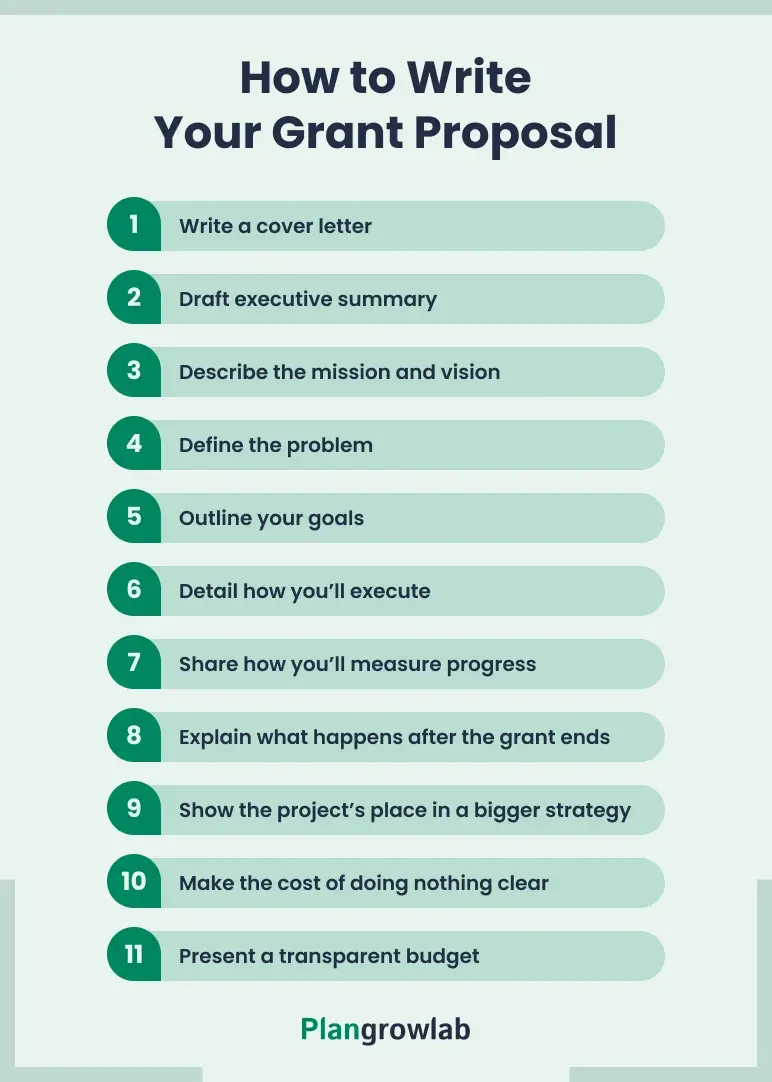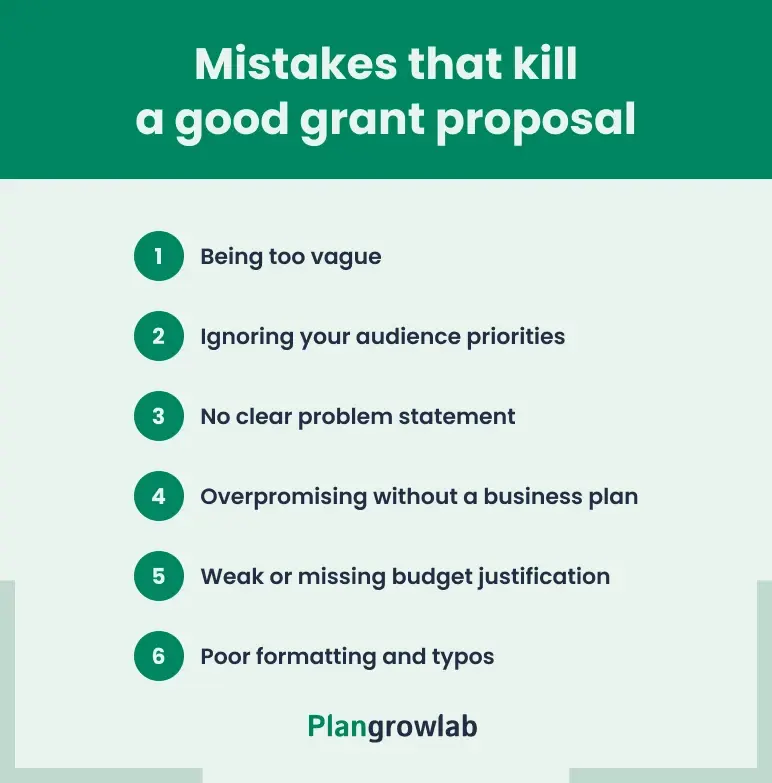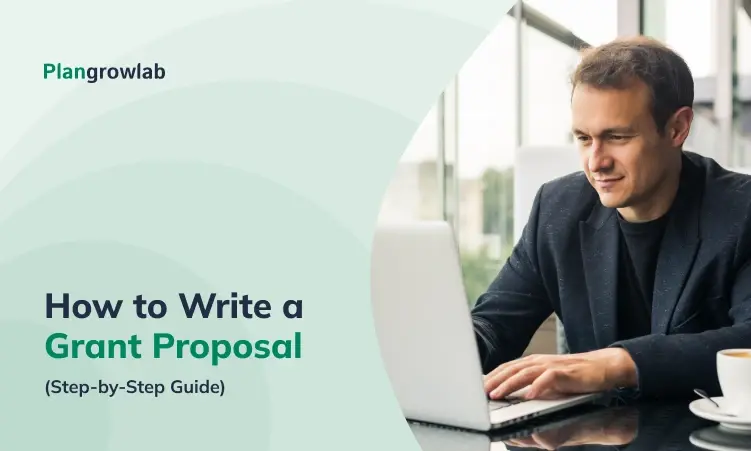Did you know? On average, only 1 in 10 grant proposals is accepted. What’s more surprising is that a poorly written proposal is one of the reasons for rejections.
But don’t worry—we’ve got you covered. In this blog, we’ve broken down a step-by-step guide on how to write a grant proposal that not only avoids common pitfalls but also increases your chances of approval.
Let’s dive in.
What is a grand proposal?
A grand proposal is a formal written request submitted to a funding organization to secure financial support for a specific project or initiative. This formal letter outlines:
- Your business proposal
- The problem you aim to solve
- Why your product matters
- How funds will be used
- What are the expected outcomes
Remember, a grant proposal may be submitted to the same audiences as a loan application. However, unlike loans, grants do not require repayment and are meant to support impactful projects.
Before you write, explore grant options and their requirements
Not every grant is the right fit for your business. You can’t just pick any grant format and start applying—doing so is like playing a blind game, and that rarely works out. If you genuinely want to secure funding, start with proper research on eligible grants.
Look into past grants—study what got approved, analyze the unique value proposition those applicants brought in, and see how you can reflect that insight in your own application.
And never forget, a solid grant proposal must clearly answer two questions: Why now? And why you? These are the heart of a persuasive business proposal. If you can’t explain this in simple, confident terms, even a great idea might get overlooked.
Also, understand what type of proposal you’re writing. Is it a formally solicited business proposal, or is it an unsolicited business proposal? Both approaches require different tones and strategies, so knowing your category early will help you prepare smarter and write stronger.
However, if you want to stay organized and make the process easier, staying connected with Plangrowlab’s grant writers can be a big advantage. They'll help you manage deadlines, collect your research, provide you with advice, and prep your documents without hassle.
How to write your grant proposal
Writing a grant proposal isn’t a simple task; you need to understand its ins and outs before you begin crafting it. Hence, here’s a step-by-step process to craft compelling business proposals:

Step 1: Write a cover letter
The cover letter is the first thing that your audience will see; hence, make it count by making a good impression. Remember, founders and investors are busy; they’ll read your letter first to decide whether they want to dive into the entire proposal.
Here’s what you should include in your cover letter:
- Greetings – Address the right person
- Title – Include the business proposal title
- Introduction – Who you are and what your organization does
- Purpose – What you’re applying for and how much funding you need
- Connection – Why your project aligns with their values or goals
- Closing – Thank them and express eagerness to share more in the full proposal.
To make it easy for you, here’s an example:
Dear Ms. Carter,
I’m writing on behalf of BrightStart Learning, a nonprofit committed to early childhood education in underserved communities. We are seeking a $25,000 grant from the Harmony Foundation to expand our mobile literacy program in rural Texas.
Your commitment to improving access to education aligns perfectly with our mission. With your support, we aim to reach 300 additional children this year.
Thank you for considering our proposal. We’d be honoured to partner with you to make a lasting impact.
Sincerely,
Jason Patel
Founder, BrightStart Learning
Step 2: Draft executive summary
A compelling executive summary is a quick snapshot of your whole grant proposal. It’s usually a couple of paragraphs or one page that sums up everything so they get the big picture fast.
Here’s what you include:
- Who you are: Provide a brief intro of your organization.
- The problem: What issue are you solving?
- Your solution: What’s your project or program, and how does it solve the problem?
- Goals & impact: What outcomes do you expect?
- Funding request: How much money you’re asking for and what it will be used for.
Here’s a small example of an executive summary:
Executive Summary:
BrightStart Learning is a nonprofit organization dedicated to improving childhood literacy in rural Texas. Many children in these areas lack access to books, educators, and structured learning environments.
To address this, we’ve developed a Mobile Literacy Program that delivers books, tablets, and teaching resources to underserved areas through converted school buses. In 2024, we successfully reached 180 children across five towns.
With a $25,000 grant from the Harmony Foundation, we aim to expand this program to reach 300 children in the next year. The funding will support vehicle maintenance, educational materials, and part-time educators.
This initiative aligns with the Harmony Foundation’s mission to promote equal educational access and promises measurable literacy improvement in high-need communities.
Step 3: Describe the mission and vision
This is where you explain the heart of your business proposal: what you’re all about and where you’re headed. This section tells them:
- What drives you (mission)
- Where you’re headed (vision)
Here’s how you should craft this section:
- For the mission, write one clear sentence about what you’re doing—like, “Our mission is to teach kids coding so they can build their own futures.”
- For the vision, paint a quick picture of the long-term win—like, “We see a community where every kid has tech skills to chase their dreams.”
- Keep it simple and tie it to what they care about, like education or helping people.
Step 4: Define the problem
Funders won’t fund a solution if they don’t clearly see the problem. So, this is your chance to show them the real need with facts, emotion, and urgency. It’s also called “a detailed problem statement.”
It’s a section where you need to show them the gap or challenge you’re tackling and the issue your project is going to fix.
The key elements that you should include in this section are:
- What are the customers’ pain points? Be clear and specific.
- Who is affected? Describe the community, group, or area impacted.
- Evidence: Use data, market research, reports, or real-life stories to support your case.
- Why now? Show the urgency—why this can’t wait.
- Why you? Mention why your organization is uniquely positioned to solve it.
Remember, if you’re able to define your problem properly, you’re already on the path to crafting a winning business proposal.
Step 5: Outline your goals
This is where you spell out what you want to achieve with your project. It’s the “here’s what we’re aiming for” part. Funders want to see what success looks like for you. Thus, clear goals show them you're not just dreaming—you’ve got a plan to deliver real, measurable results.
To craft this section, you should include key components:
- Short-term goals: What you’ll achieve during the grant period.
- Long-term goals: The impact your project will have over time.
- Link to the problem: Each goal should connect directly to the issue you defined earlier.
Here’s an example:
- Write a couple of short, specific goals—for example, “Teach 20 kids basic coding in 6 months” or “Set up a weekly coding club at the library.”
- Make them measurable so everyone knows when you’ve hit them—using numbers or a timeline.
- Tie them back to the problem, so it’s obvious how they help—like, “This gives kids the tech skills they’re missing.”
Step 6: Detail how you’ll execute
Show your game plan and how you’re going to make those goals happen. To secure funding, you need to ensure your potential client that you have a clear map to execute the plan; this is how you are going to make things happen.
Outlining your execution plan builds trust and gives funders confidence that you can deliver on your promises.
To make it simple for you, here’s how you can do it:
- Break it down into a few steps—“We’ll recruit 20 kids through flyers at school, hold weekly coding classes at the library, and use free online tools to teach them.”
- Mention who’s involved—like, “Me and two volunteer teachers will run it.”
- Add a basic timeline, such as, “We’ll start in June and run classes till November.”
- Keep it practical, like explaining to me how you’d fix up the garage—step-by-step, no fluff.
Step 7: Share how you’ll measure progress
Funders don’t just want results; they want proof of results. When you clearly show how you’ll measure success, it tells them you’re serious about accountability and improvement.
Here’s how you describe your progress:
- Pick a few clear ways to check progress—for example, “We’ll count how many kids finish the coding classes” or “We’ll test them on a simple program at the end.”
- Keep it tied to your goals—say, “If 15 out of 20 kids learn to code, we’re on track.”
- Mention how you’ll track it, such as, “We’ll keep a sign-in sheet and save their projects.”
Step 8: Explain what happens after the grant ends
Funding bodies love it when you show you’re not just chasing money; you’re building something that lasts. Thus, inform your audience how your project keeps going or leaves a lasting mark once the grant money is spent. It’s often called the “sustainability” or “impact” section.
How to do It:
- Say how it’ll keep running—“After the coding classes, we’ll train two kids to teach others or get donations for more sessions.”
- Or explain the lasting effect—“The 20 kids we teach will have skills for school and jobs.”
- Keep it real and short—tell me how your new bike will still be useful after the summer.
Step 9: Show the project’s place in a bigger strategy
Your compelling proposal shouldn’t stand alone. It should be part of a larger vision—whether that’s community transformation, national policy change, or long-term economic development. This step shows you’re not thinking small or short-term.
In this section outline:
- How your project supports your organization’s long-term goals.
- Who else is involved or could be involved to expand the impact?
- How this project acts as a stepping stone to future initiatives.
- How does your work support larger movements or development frameworks
Step 10: Make the cost of doing nothing clear
Sometimes, people act not because of what they gain but because of what they’ll lose if they don’t. This step adds urgency. It shows that delaying or ignoring your project has real consequences.
Hence, to create urgency, craft your section like this:
- Paint a quick picture of the fallout—say something like, “If we don’t teach these kids coding, they’ll miss out on tech jobs down the road.”
- Add a punch with a fact or feeling—for example, “Half the jobs in ten years might need tech skills they won’t have.”
Step 11: Present a transparent budget
If you want to craft a winning business proposal, be clear and honest with your budget. It shows funders you’ve thought through every expense and know exactly how their money will be used.
No fluff.
No guesswork.
No wrong financial projections.
Just solid numbers.
Here’s how you should plan this section:
- List the big stuff you’ll spend on—for example, “$2,000 for laptops, $1,000 for teacher pay, $500 for snacks at coding classes.”
- Briefly explain why each cost is necessary.
- Mention any other contributions—grants, sponsors, or your investment.
- Be precise, and make sure it aligns with your plan.
That’s it! With these steps, you now know how to write a business proposal for funding. However, writing compelling business proposals requires thorough research and a clear understanding.
Using grant writers or a free business proposal template can be a smart move if you prefer not to handle the entire process on your own.
Make sure your proposal is reviewer-friendly
Keep in mind that the folks reading your proposal are busy. Sometimes, they’ve got a pile of 10 to 15 proposals sitting on their desk. So yours? Needs to stand out and be easy to read.
Hence, keep your proposal clean and clear. A well-crafted business proposal includes:
- Simple formatting
- Bullet points
- Tables
- Short sentences
Structure it well, like a business plan, keeping a logical flow. Don’t make your audience search for your proposed solution, value proposition, or budget, but guide their eyes naturally.
Make it skimmable. Ask yourself: If someone had only 5 minutes to skim this, would they understand what I’m asking for, why it matters, and what impact it’ll have? If not, go back and simplify.
Trust me, a reviewer-friendly proposal can be the difference between landing that grant and getting overlooked. Don’t make them work for it—make it effortless to say yes!
Need expert advice to perfect your grant proposal?
Get in touch with our experts to gain actionable feedback to refine your proposal and your entire business plan faster than ever.
Common mistakes that kill a good grant proposal
Over the years, we’ve seen that effective grant proposals get tossed aside, not because they were bad, but because the proposals had major flaws. Let us save you from those mistakes:

1) Being too vague
If you’re not clear about what you want to do, no one’s going to trust you with their money. Be specific—what, how, when, and why.
2) Ignoring your audience priorities
One size doesn’t fit all. If your proposal doesn’t align with the funder’s mission or guidelines, it’s an automatic no. Always customize it.
3) No clear problem statement
If you can’t define the problem well, your solution won’t matter. A weak problem statement makes the whole proposal fall flat.
4) Overpromising without a business plan
Big promises without a solid execution plan scream “unrealistic.” Your audience wants to see ambition backed by logic, not just big dreams.
5) Weak or missing budget justification
Throwing numbers without explaining them is a red flag. Every cost should have a reason. If they can’t see where the money goes, they won’t give it.
6) Poor formatting and typos
You could have the best idea in the world, but if your proposal looks messy or has grammar issues, it screams unprofessional. Proofread, format, and make it easy on the eyes.
Wrapping up
All set! With these steps and tips mentioned in this blog, you are ready to craft an effective business proposal that grabs attention and increases the chance to secure funds.
However, crafting a winning proposal requires careful planning, research, and competitive advantages. Remember, even a small mistake can cost you a grant worth thousands of dollars.
Hence, if you’re unsure where to begin, reviewing a successful grant sample can help you understand how to kickstart your proposal with clarity. Or you can just let Plangrowlab review your existing grant proposal.
In fact, we can assist in updating your entire business plan to align with grant guidelines, refining your funding strategy, or even exploring alternate funding options in case a grant doesn’t work out.
So, wait no more; get in touch with our experts.
Frequently Asked Questions
Can I apply for multiple grants at once?
Yes, you can—and you should. Just make sure each application has a compelling business proposal tailored to the specific funder.
Do I need a registered business to apply for a grant?
Not always. Some grants are open to individuals or nonprofits, but many do prefer working with a registered entity, especially if you're pitching to a prospective client or organization.
Are grants taxed like income?
It depends on your location and how the grant is used. If it’s for personal gain, it might be taxable—check local tax rules or ask an accountant.
Is it okay to reapply if I got rejected last time?
Yes! Just refine your value proposition, tighten your persuasive business proposal, and learn from the previous feedback.
How long does it take to hear back after submitting a grant?
Anywhere from a few weeks to a few months. While you wait, consider improving your business proposal template and preparing for the next opportunity.

